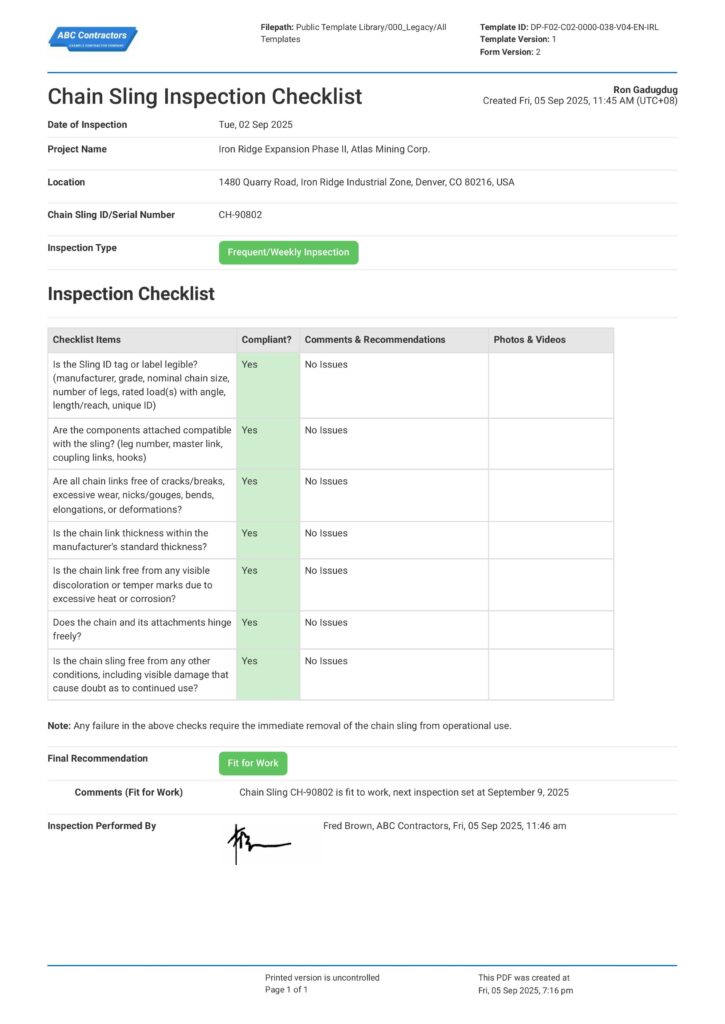Article Page – How Often Should Slings be Inspected
How Often Should Slings be Inspected?
Chain Slings are an important attachment for most modern-day lifting operations in most high-risk industries. Here, we discuss how their regular inspection and maintenance affect workplace safety, compliance, and equipment certification and the free tools and resources to be used.
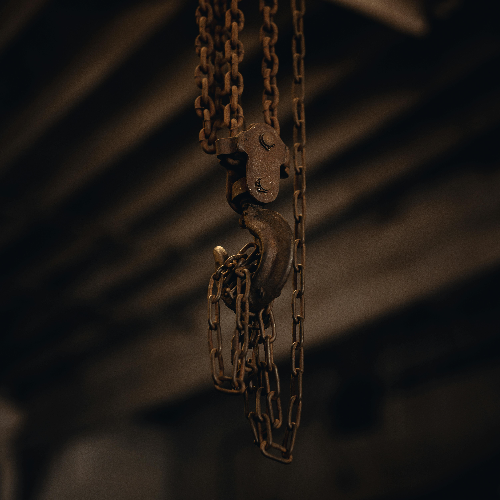
Table of Contents
Article Summary
- Tools like chain sling inspection checklists are important to ensure a proper inspection and, ultimately, to ensure the safety of your workers and compliance to industry regulations.
- A proper sling inspection should be done as regularly as possible. Multiple safety agencies and institutions recommend initial inspections, frequent or pre-shift inspections, thorough examinations, and special inspections.
- Multiple regulators have set their requirements on chain sling inspection, operation, and maintenance (OSHA 29 CFR 1910.184; ASME B30.9; ISO 4779; HSA GAWR 2007).
Why are Chain Sling Inspections Important?
Chain Slings, usually made up of high-strength steel alloy, are usually used in lifting operations, rigging, and material handling & transportation. They are valued for their strength, durability, and reliability, while still being flexible enough to be used for various situations and applications.
Before sale, most manufacturers now certify their chain slings are proof-tested to at least 2x their Working Load Limit (WLL) to ensure safety.
However, it is subject to high loads, intensity, and vibrations, even in normal use. Thus, it is exposed to higher risk of wear & tear, damage, or failure. To ensure workplace safety, institutions like the ISO, OSHA in the USA, the Health and Safety Authority (HSA) in Ireland have issued regulations for chain sling inspection & maintenance. These are highly relevant in industries such as construction, marine engineering, transportation, shipping, and even forestry.
How Should Proper Chain Sling Inspections be Set-up?
Chain sling inspections are an important procedure to ensure the safety of your workers and compliance to regulations. Generally, there are no required formats for inspections and reports for chain slings in specific. However, there will be information and inspection points that you will always have to go over.
Typically, you are expected to verify information such as the dates of the inspection, identification of the chain sling (labels, markings, etc.), any defects or non-compliance, and any recommendations. Many engineers now use tools like checklists, like the Chain Sling Inspection Checklist in the example below, to list down their inspection points to ensure compliance.
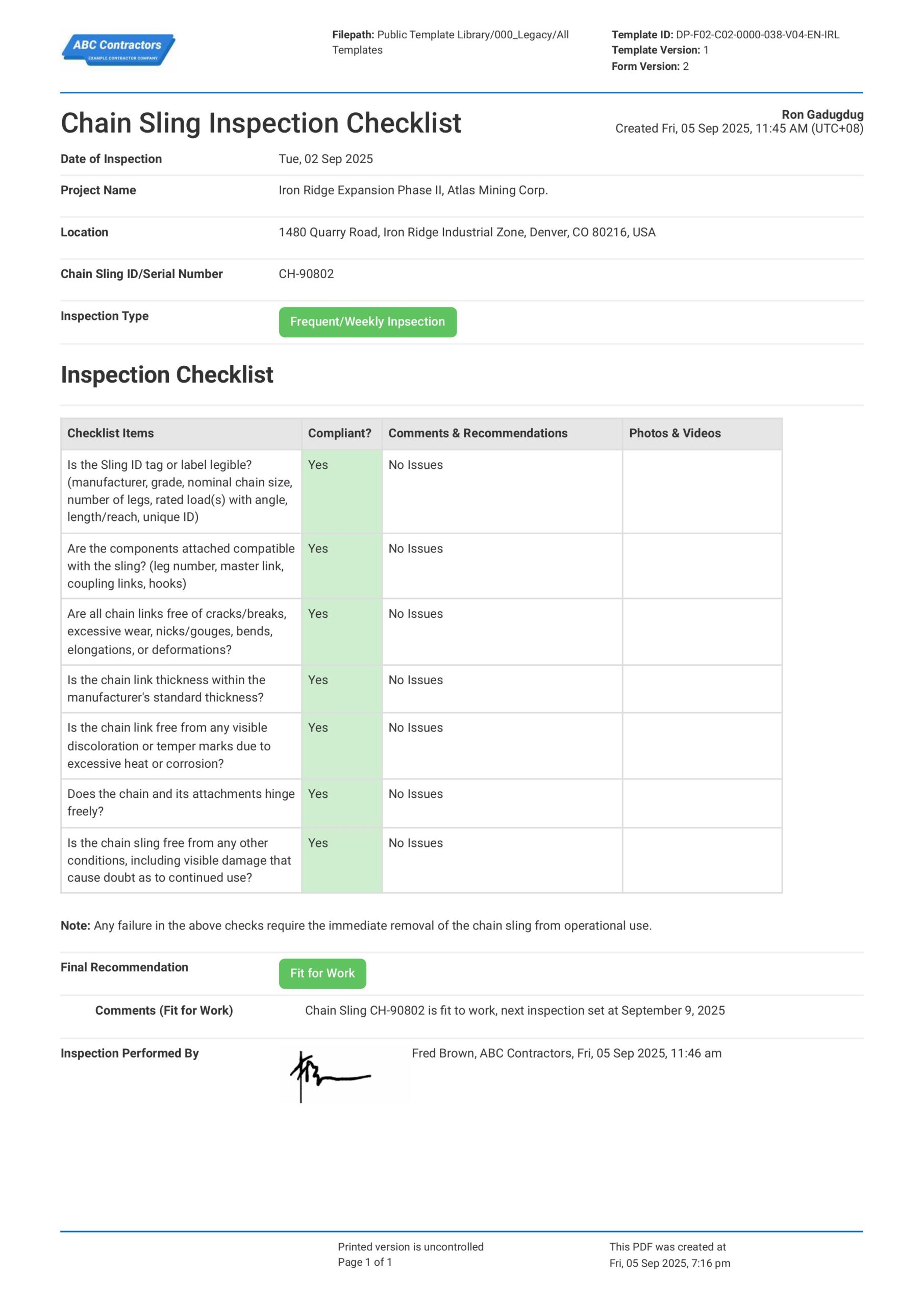
Use this Chain Sling Inspection Checklist for free
What are the Chain Sling Inspection Criteria for Safety & Compliance?
Chain sling inspection criteria usually varies between safety organizations accross the world. However, some that are universally accepted are:
Types of Inspection
Some safety regulators like the HSA and OSHA define different types of inspections that you will to perform and comply with. To enumerate, these are initial inspections, frequent or pre-shift inspections, periodic inspections or thorough examinations, and special inspections.
Visual & Functional Inspection Flags
In order to perform proper inspection, you will need to be aware of the following tell-tale, visual inspection points that may warrant the removal of a sling from operation:
- Wear & tear in the form of stretching and deformation
- Cracks, dents, or nicks on the chain
- No cracks or excessive wear on the saddle of hooks and other fittings
- No excessive corrosion or rusting
Further, you will also need to conduct occasional functional testing on the chain sling. For chain links, you can expect simpler functional testing points such as the free movement of the links, swivels, and couplings, ensuring the chain sling articulates without obstruction.
Best Practices for Operation, Maintenance, & Storage
To preface, it should be noted that the best practices will differ largely on the exact model chain sling you are using. It will be best to consult your manufacturer for exact information on the operation, maintenance and storage of your chain sling.
However, OSHA in the USA and the HSA/ISB in Ireland have advised some requirements on best practices that, ideally, should be followed universally:
- The chain must be of good construction, suitable material, and adequate strength
- The chain must be used for and under the manufacturer’s capacity design.
- No modification must be made to the chain sling without explicit advice from the manufacturer
- Thorough examinations and inspections must be conducted regularly
- Store chain slings in clean, dry places to prevent corrosion, exposure to excessive moisture, heat, or chemicals
Chain Sling Inspection: Requirements for Equipment Certification
Once your team has completed the actual inspections, you will need to prepare the relevant documentary support next to ensure compliance. For example, you can expect your manufacturer to provide a certificate of conformity for your chain sling. This would include information such as the manufacturer’s name/address, specifications for the sling, the working load limit (WLL), and even test results from in-house testing of the sling.
Typically, you will be required to provide inspection reports, test logs and results, and other documentation to certify that your slings are well-maintained. However, it will be best to check with your local safety agency for the list of requirements specific to you.
Another example of an equipment certification is a report of thorough examination. This document is required by the Health and Security Authority in Ireland, and is usually in the form of a HSA GA1 lift assessment form.
When Should Slings be Inspected?
Ideally, chain slings should be inspected as regularly as possible, given its constant use under heavy loads. According to prominent workplace safety regulators, such as OSHA and the HSA, inspection frequency can be categorized and defined as such:
- Initial Inspections - Performed when the chain sling is first acquired and before it is first put into use
- Frequent or Pre-Shift Inspections - Usually done daily, weekly or before every use or every shift, depending on the specific manufacturer or regulatory requirement
- Periodic Inspections or Thorough Examinations - Specifically required by OSHA and the HSA, performed every 6 to 12 months. This should include an in-depth functional testing
- Special Inspections - Performed after a “special” incident occurs, such as the repair or recommissioning of a chain sling (in order to certify its fitness for work), or after an accident or incident of damage as an investigatory inspection
It's not just slings that should be inspected, but also winches and shackles – being critical components in lifting equipment should be inspected and maintained regularly. This is where a Winch Inspection and a Shackle Inspection come in handy.
Improving your Sling Inspection Process
Lifting equipment like chain slings are constantly exposed to higher risk of wear and tear. Frequent inspections are required to ensure your slings are always fit for work. As a result, teams who are not prepared can get overwhelmed by the amount of paperwork involved.
Luckily, this Site and Field Inspection Software can help you alleviate some of that labor-intensive, paper-centric workload. Streamline your work flow by incorporating digital tools and solutions like this app to document site inspections, take down notes, and attach relevant photos.
Summary of How Often Should Slings be Inspected?
Your chain slings should undergo initial, frequent or pre-use, periodical, and special inspections. This ensures that your slings are regularly inspected and well-maintained for normal operations. Several safety institutions require you to perform these inspections, and non-compliance can result with penalty fees, work stoppages, and even serious legal consequences.
Frequently Asked Questions
Are Chain Sling inspections required by any regulation or law?
Yes, inspections and thorough examinations for chain slings, and are required by several safety institutions and agencies over the world. The ISO (ISO 4779:2021), the HSA in Ireland (HSA GAWR 2007), and OSHA (OSHA 29 CFR 1910.184), among others, have set specific regulations on chain sling inspections, maintenance, and operation. Failure to comply with these standards may result in penalty fees, work stoppages, and even legal consequences for you and your company.
How can technology improve the way chain sling inspections are conducted?
Modern day engineers and technicians take advantage of digitalization to help them perform inspections and create & store reports. Tools like online checklist, form, and report templates help them unify their inspection process and automate the creation and archiving of their documents. This helps streamline workflows, lessen delays, and improve accuracy and consistency in the quality of their work.
Does Sitemate offer any templates about chain sling inspections?
Yes - Sitemate offers a wide range of templates for safety and quality inspections, including a Chain Sling Inspection Checklist that you can use to streamline your team’s inspection work processes. Take advantage of digital solutions and give your team the edge it needs to stay competitive.
Related resources
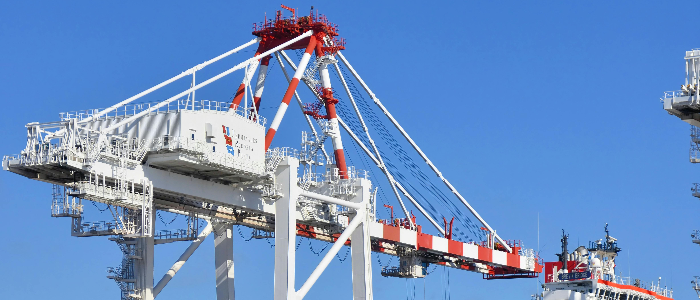
HSA GA1 Form: Lift Assessment Form
Streamline the inspection procedure for lifting equipment to consistently meet HSA requirements.
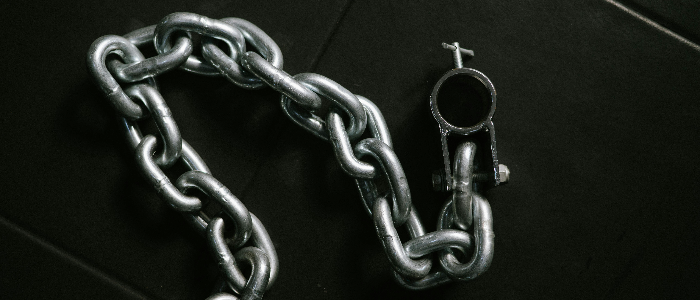
Shackle Inspection Checklist
Log inspection details seamlessly and report when shackles are not up to standard.
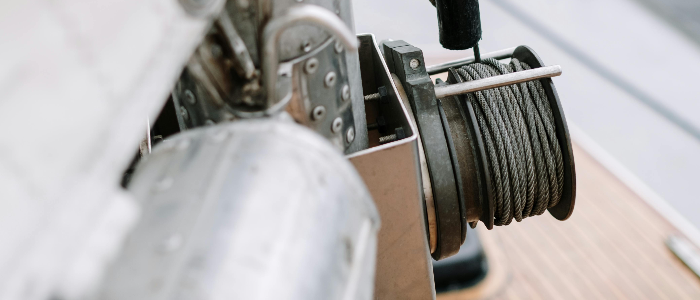
Winch Inspection Checklist
Conduct winch inspections prior to using lifting equipment.
